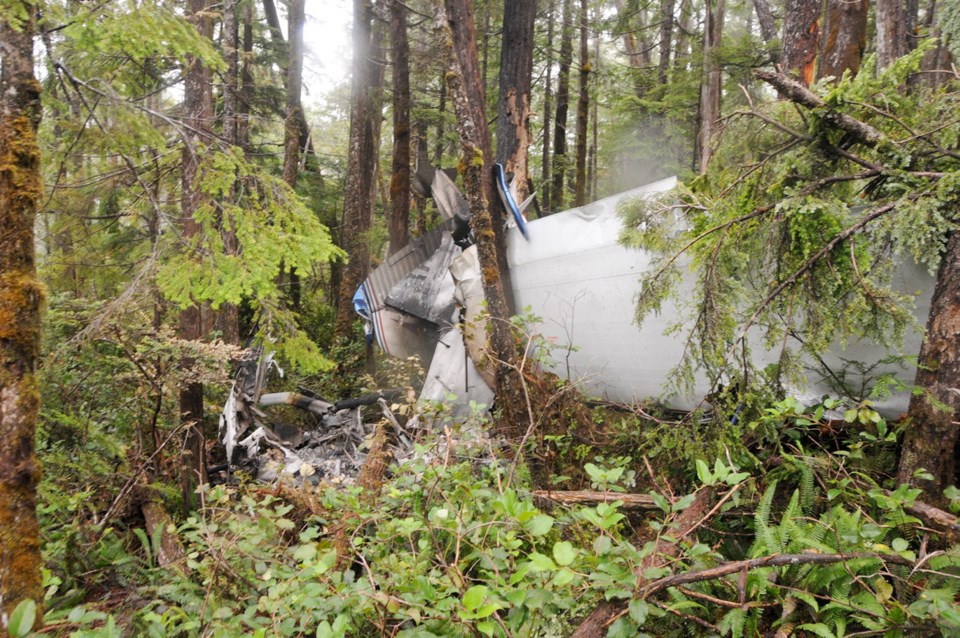According to one of the survivors of the float plane crash Friday morning on Vancouver Island, the aircraft burst into flames upon impact, and the ensuing fire may have been what killed the pilot and one of five passengers.
The crash happened just weeks after the release by the Transportation Safety Board of a report saying Transport Canada’s failure to implement recommendations to prevent or mitigate post-crash fires in small planes was placing pilots and passengers at risk.
“These issues that are apparent this time, in this investigation (of Friday’s) accident, have been raised by several agencies, the coroner and ourselves,” said Bill Yearwood, regional manager and spokesman for the safety board. “We will continue to draw attention to those if, in fact, they did play a part in the loss of life.”
In the report, the safety board said proximity to engine fuel, limited escape time, the likelihood of immobilizing injuries, and the long distance from emergency personnel increases the risk to passengers on small planes.
Avid outdoorsman John Young and four others had been hiking the remote, fly-in Hesquiaht Peninsula trail. They were returning to Gold River, where charter float plane company Air Nootka is based north of Tofino.
The plane crashed three minutes after takeoff, killing the pilot and one other. Neither have been identified.
Young was seriously injured, suffering a shattered sternum, broken ribs, broken clavicle, and third-degree burns to his legs. He remains in Victoria General Hospital.
A second hiker was also hospitalized with unknown injuries, and two others walked away unharmed. It is believed they were seated in the rear of the de Havilland Beaver. Young said the fire started in the front.
Transportation Safety Board investigators were expected to reach the site by lunchtime on Monday. Days of poor weather slowed progress because the site is accessible only by air or hike. It also prolonged the search for the wreckage on Friday, which took over four hours and the concerted effort of numerous agencies and volunteers.
Since 2006, the board has been calling for changes such as a way to kill the battery and therefore cut power to the fuel pump, eliminating any ignition source. The safety board has called Transport Canada’s response “unsatisfactory.”
Last May, a similar float plane went down near Peachland, and a post-crash fire killed three people on board, including the pilot. And in 2011, the highly publicized crash of a Northern Thunderbird Air Beechcraft King Air 100 at Vancouver International Airport killed both pilots and severely injured seven others when the plane burst into flames on the runway.
In 2012, a coroner’s review panel into 23 deaths caused by four float plane crashes over five years said Transport Canada should require float plane passengers to wear flotation devices, and require planes to have rapid-escape emergency exits. Young described difficulty in opening the plane’s doors after Friday’s crash.
The panel also reiterated the need to install battery-killing devices to prevent post-crash fires. Transport Canada has said it supports the recommendations, but none of the major reforms have been implemented.
“The department understands and supports the intent of the Transportation Safety Board’s position. To reduce the number of post-impact fires and increase survivability of passengers, (Transport Canada) and other regulators continue to work toward developing improved standards,” spokeswoman Karine Martel wrote in an email, adding planes are now required to increase fire resistance of the fuselage and some on-board components like seats and overhead bins.
“In the case of the kill switch, safety authorities around the world share the position that the kill switch is not an absolute solution, and that there are risks with the technology. The challenge is finding solutions that are practical on a wide range of aircraft types and ages. (Transport Canada) continues to work with its international partners to ensure a harmonized approach to aircraft design standards, as aircraft are exported to other countries.”
Transport Canada, working with the U.S. Federal Aviation Administration and European Aviation Safety Agency, is focused on prevention and addressing areas like loss of control, mismanagement of engine failure by pilots, and what is known as “controlled flight into terrain,” where the pilot unintentionally flies the aircraft into the ground.
Yearwood said the exact cause of Friday’s crash was unknown — whether mechanical, weather-related, or a combination — but the pilot in this case did have plenty of experience, and investigators are looking into other factors.
“The signatures of this accident as we can see already draw attention to things the board continues to raise as issues, and that’s post-crash fires. We know there’s been a post-crash fire in this accident.”
Manufacturers have improved the exits on some Beaver aircraft, but it wasn’t immediately known if the plane in this case had those upgrades.



